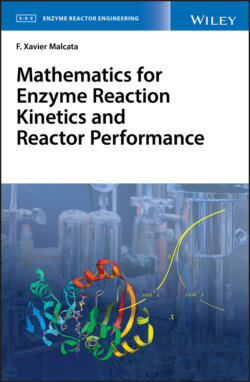Читать книгу Mathematics for Enzyme Reaction Kinetics and Reactor Performance - F. Xavier Malcata - Страница 37
2.4.4 Inverse Functions
ОглавлениеInverse hyperbolic functions are often useful, and will accordingly be discussed next; in the case of sinh−1 x, one should start by setting
(2.566)
so application of hyperbolic sine to both sides gives rise to
(2.567)
– since composition of a function with its inverse cancels out their mutual effects. Insertion of Eq. (2.567) allows transformation of Eq. (2.496) – rewritten in (dummy) variable y, to
(2.568)
so adding x2 to both sides and taking square roots thereof afterward generate
(2.569)
here only the plus sign was kept, since cosh y > 0 as per Fig. 2.14a. Based on Eq. (2.479) rewritten for y, one finds that
(2.570)
following combination with Eqs. (2.567) and (2.569) – or, after applying logarithms to both sides,
(2.571)
that is the same to write
(2.572)
as per Eq. (2.566); a plot of Eq. (2.572) is conveyed by Fig. 2.15a. Note that , so in view of Eq. (2.2); therefore, the argument of the logarithm in Eq. (2.572) is always positive, and sinh−1 x is defined for all real numbers.
Figure 2.15 Variation, with their argument x, of inverse hyperbolic functions, viz. (a) inverse hyperbolic sine (sinh−1) and cosine (cosh−1) and (b) inverse hyperbolic tangent (tanh−1) and cotangent (cotanh−1).
By the same token, if one sets
(2.573)
then hyperbolic cosine may be applied to both sides to produce
(2.574)
– again due to the inefficacy, with regard to its argument, of composing a function with its inverse. Upon combination of Eq. (2.496), rewritten for y, with Eq. (2.574), one obtains
(2.575)
where isolation of sinh y yields
(2.576)
– with both signs preceding the square root being now feasible, since sinh y may take either positive or negative values (see Fig. 2.14 a); once in possession of Eqs. (2.574) and (2.576), one may resort to Eq. (2.479), with x relabeled as y, to write
(2.577)
Application of logarithms to both sides of Eq. (2.577) finally gives
(2.578)
or else
(2.579)
with the aid of Eq. (2.573), as depicted also in Fig. 2.15a. In this case, is defined only when x2 > 1, or else x < − 1 ∨ x > 1; furthermore, , thus implying that when x < −1, but for x > 1 – so only the latter can be taken as domain for cosh−1 x, so that logarithm thereof can be defined. However, , so two possible values actually arise, i.e. cosh−1 x is a double‐valued function; only the positive value of the logarithm is usually considered, thus implying use of the positive sign preceding the square root in its argument.
Following a similar rationale, one may calculate the inverse hyperbolic tangent – by, once again, setting
(2.580)
at startup, in parallel to Eq. (2.566) – thus implying that
(2.581)
as per composition of functions; consequently,
(2.582)
owing to Eqs. (2.482) and (2.581), which becomes
(2.583)
after elimination of denominator. Upon insertion of Eq. (2.581), one obtains
(2.584)
from Eq. (2.511), with x replaced by y – which readily becomes
(2.585)
only the plus sign preceding the square root was taken here, because sech y only takes positive values (see Fig. 2.14 c). One may now revisit Eq. (2.479) as
(2.586)
at the expense of Eq. (2.583), along with factoring out of cosh y; in view of Eq. (2.487), one may redo Eq. (2.586) to
(2.587)
where insertion of Eq. (2.585) permits further transformation to
(2.588)
Since a difference of squares is expressible as the product of two conjugate binomials, Eq. (2.588) unfolds
(2.589)
or else
(2.590)
after cancelation of between numerator and denominator; following application of logarithms to both sides, Eq. (2.590) turns to
(2.591)
where Eqs. (2.25) and (2.580) support final transformation to
(2.592)
– defined for ∣x ∣ < 1 only, so as to guarantee a positive argument for the logarithm. Equation (2.592) is illustrated in Fig. 2.15 b; note the monotonically increasing pattern of tanh−1 x, spanning]−1,1[ as domain; at either x = −1 or x = 1, a vertical asymptote arises – according to
(2.593)
that drives the curve toward −∞ at x = −1, coupled with
(2.594)
that drives the curve toward ∞ at x = 1.
The inverse hyperbolic cotangent may be obtained after applying the hyperbolic tangent operator to both sides of Eq. (2.592), namely,
(2.595)
once reciprocals are taken of both sides, Eq. (2.595) becomes
(2.596)
– also with the aid of Eq. (2.483). Division of both numerator and denominator of the argument of the logarithm function by x converts Eq. (2.596) to
(2.597)
where a change of variable to is in order, i.e.
(2.598)
all is left is taking the inverse hyperbolic cotangent of both sides, according to
(2.599)
where retrieval of the original (dummy) variable x unfolds
(2.600)
Equation (2.600) is depicted in Fig. 2.15 b; it is not defined within [−1,1] since x – 1 < 0 in that range would compromise existence of the logarithm. Outside said range, one notices that
(2.601)
based on Eq. (2.600) – so x = −1 drives the behavior of cotanh−1 x toward −∞, in the neighborhood of −1; by the same token,
(2.602)
so cotanh−1 x tends to (positive) infinite when x = 1 is approached – meaning that x = 1 serves as vertical asymptote as well. For the remainder of its domain, this inverse function is monotonically decreasing in either interval]−∞,−1[ or]1,∞[; when x →−∞, one obtains
(2.603)
stemming from Eq. (2.600) – and similarly when x → ∞, i.e.
(2.604)
because x + 1 ≈ x and x − 1 ≈ x, thus indicating that the horizontal axis plays the role of (single) horizontal asymptote when x grows unbounded.
